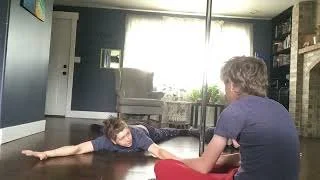Describe your process. How did you choose your project? Why did you choose this method?
My project is totally based around focused simple games. This concept was totally new to me when learning it in FFTT (the props class was my favorite!) and I wanted to incorporate it more in my work as a pole dance instructor and in radical unschooling my kids.
I’ve learned that I tend to overcomplicate, over-communicate and even create too many visuals while I teach. So my goal in this project was to experiment with focused simple games with myself (who struggles to want to get on the floor while pole dancing) and my kids (who are totally inexperienced in floor work movement and have a short attention span).
With myself and the pole, I gave myself the limits that my feet could glide but could not leave the floor. I also had to factor in the limits of my stage and fight the urge to do higher pole moves; To help with these limits, I preemptively kept on pants and socks, I allowed myself to go off the stage but still do my best to keep my feet close to the floor. I tried lots of variations in weight transfers with standing, squatting, lunging, kneeling and laying on different levels to test if I could keep to the game.
Teaching a simple loop to my kids, I decided to focus on basic moves like the “X” shape, the attitude lift, and the hand sandwich sit up/down. With each move, I had them watch me demo, then I explained how to make it easy, then they tried it. They aren’t used to rolling on a hard floor so they complained quite a bit at first about the pressure on their joints. When we repeated the moves together and there was a light bulb moment where they saw they could do each move and complained less. Their game was to practice one move at a time for 20 seconds each. Then when they combined all the moves together, they pretended they were moles in a wack-a-mole game and had to roll and sit up in the next hole on their side of the room. They did that for one song and had fun but decidedly done doing the moves once the song was over.
2.. What felt good ( or provided a healthy challenge) in creating this project?
Pole: It felt good to see how many different variations were available to me when I gave myself perimeters and just played. It was a healthy challenge to not come off the ground as that was is always my go to.
Kids loop: It felt good to see my kids follow my instruction and smile and laugh as they started to understand their own capabilities! It was a healthy challenge for me to cue them differently when it came to how yucky they felt being on the floor and how smooth landings make all the difference! My oldest son said when he was finished, “Hey it kinda hurt my shoulder when I was on the ground, but now I’m up and walking around any my body feels much better!”
3. What do you think your project offers the viewer/participant?
I think both viewpoints (me with pole/kids) helps see how important our awareness and use of the floor can be. We tend to forget that there’s a whole world of movement when we can connect with the floor and that we can be surprised at what our bodies can do when we trust the floor more than fear it.
4. If there is ONE thing that you would do differently, what is it?
Pole & Kids: I would’ve listened to music on a different device so I didn’t have to record in time-lapse. There were moments of understanding and excitement in both that I wish I could’ve caught on camera.
5. What did you learn from this experience that you will apply to your own training or teaching?
I learned that when teaching pole, allow more games like this to help students build trust with the floor and their own creative capabilities.
I learned that when teaching children, repetitive movement can get boring and so it’s best to give them a count down to know there’s an end in sight and simple focused games to make it fun. Also, I realized I didn’t do very well at explaining weight distribution to my youngest son and in forgetting that detail, he got overwhelmed fast. I would’ve gone back and did more rocking and swaying motions prior to the attitude lift to help him understand where it’s easier if his chest is forward vs. backward.
2C.What did you do? Why should anyone watch it?
Get out of your head, don’t overcomplicate it! This final project is based around simple focused games in two different scenarios: pole dancing without leaving the floor and a simple loop taught to kids.
2D. Cover Image:

